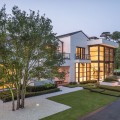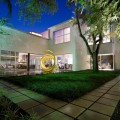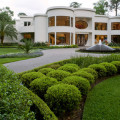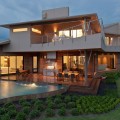Contemporary Backyard Design
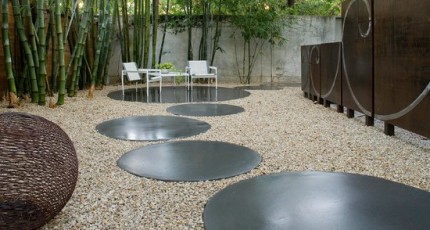
A contemporary backyard typically follows the same design principles of Mentalism and minimalism that are apparent in contemporary front yards. These properties deliberately de-emphasize Nature, and place greater significance on architecture and human design. The pre-eminence of human achievement is the primary focus, while natural elements act as supporting elements to man-made structures. Contemporary backyards almost invariably extend the aesthetic themes of home architecture backward into the remainder of the landscape—suggesting that human progress in ongoing and ever expanding. They also typically reflect the basic geometry, linearity, and angular emphasis that characterize the aesthetic of the contemporary home itself. Exterior structures, minimalist plantings, outdoor art, and custom hardscapes all combine into patterns representative of homeowner mindset, values, and lifestyles.
Vegetation is kept to minimalist proportions in contemporary backyards. This is not to say that vegetation has no value in these environments, nor is this to suggest that these landscapes be developed as completely barren. Quite the opposite is the case. Contemporary design actually features a significant amount of greenery, but the appearance of the greenery itself is markedly different from what we would typically expect to find the average backyard. There is a strong emphasis on color and a deliberate reshaping of form intended to match organic elements to the patterns of human structures. Plants are trimmed close to the ground to make them appear less organic. In a contemporary backyard, this design works to suggest that Nature is a frame to human development, design, and construction—not a viable element independent in its own right.
Contemporary backyards are very frequently linked to art and art collecting. Contemporary styles in general tend to be highly eclectic and admittedly not for everyone. Individuals who prefer this form of aesthetic are typically people with a personal passion for art. A large percentage of them are professional artists, art collectors, or art consultants who prefer that their home and property function as a direct expression of their personal tastes and values. Most of these residents enjoy decorating their backyards with abstract sculptures and three-dimensional forms that effectively extend their interior design and private art collections into outdoor, public space. Displays of this nature are also emblematic of profession and personal mindset, and they help to further distinguish the home and surrounding yard as direct extensions of the consciousness of homeowner’s consciousness.
Perhaps the most significant factor in a contemporary backyard is an emphasis on strong forms. While some contemporary design is admittedly abstract in many ways, this is not to say that form is abandoned or that objects themselves cannot be recognized. Rather, the intention here to take basic geometric patterns, combine them into new patterns, and then morph the resulting conglomerate into a new form independent of those that exist in Nature itself. This establishes the ideal that human intention and deliberate action are key contributors to any final outcome, and it reinforces the belief in human supremacy over Nature. Nature is therefore shaped in a contemporary backyard, never eliminated.
One way this is often done is to establish a strong sense of contrast between one element and another. Human consciousness is multi-dimensional, and the deliberate contrasting of design and form transforms the landscape into an expression of the complexities of both conscious and unconscious forces of the human mind. Strong angular lines and perfect arcs are commonly used patio design, boundary and decorative walls constructions, and custom hardscape design. Gravel is a preferred substitute for grass in many contemporary backyards, replacing large portions of greenery with contrasting shades of light and darkness, or even the absolutes of black and white. Trees can be very small or very tall, depending on the height of the home. However, in most contemporary landscapes the limbs of most trees are deliberately trimmed in order to give them a more visibly sculpted shape that better supports the emphasis on man-made structures and design

